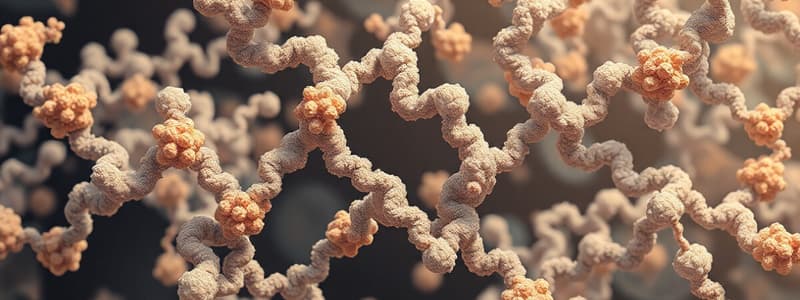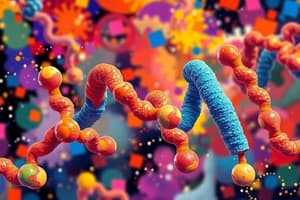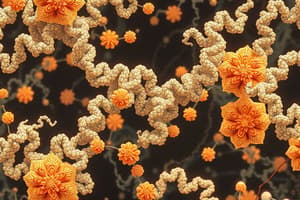Podcast
Questions and Answers
What describes the arrangement of polypeptide chains into a functional protein?
What describes the arrangement of polypeptide chains into a functional protein?
- Primary structure
- Tertiary structure
- Quaternary structure (correct)
- Secondary structure
Which type of interaction is NOT typically involved in stabilizing protein quaternary structure?
Which type of interaction is NOT typically involved in stabilizing protein quaternary structure?
- Hydrogen bonds
- Hydrophobic interactions
- Ionic bonds
- Disulfide bridges (correct)
Which structural characteristic of a protein formed from multiple polypeptide chains is described by its quaternary structure?
Which structural characteristic of a protein formed from multiple polypeptide chains is described by its quaternary structure?
- The folding pattern of a single polypeptide
- The sequence of amino acids in a polypeptide
- The spacing between individual amino acids
- The overall shape and organization of the entire protein complex (correct)
What distinguishes fibrous proteins from globular proteins?
What distinguishes fibrous proteins from globular proteins?
Which statement is true regarding the interactions among subunits in a protein's quaternary structure?
Which statement is true regarding the interactions among subunits in a protein's quaternary structure?
What type of bond is formed between amino acids during the formation of proteins?
What type of bond is formed between amino acids during the formation of proteins?
What determines the primary structure of a protein?
What determines the primary structure of a protein?
Which statement best describes non-polar amino acids?
Which statement best describes non-polar amino acids?
How are polypeptide chains synthesized?
How are polypeptide chains synthesized?
Which level of protein structure is primarily determined by hydrogen bonding between backbone atoms?
Which level of protein structure is primarily determined by hydrogen bonding between backbone atoms?
What is an essential characteristic of tertiary protein structure?
What is an essential characteristic of tertiary protein structure?
What results from the interaction of multiple polypeptide chains in a protein?
What results from the interaction of multiple polypeptide chains in a protein?
Which class of amino acids is characterized by having uncharged, polar side chains?
Which class of amino acids is characterized by having uncharged, polar side chains?
What primarily stabilizes the secondary structures of proteins, such as α-helices and β-sheets?
What primarily stabilizes the secondary structures of proteins, such as α-helices and β-sheets?
Which statement best describes the difference between the α-helix and β-sheet structure?
Which statement best describes the difference between the α-helix and β-sheet structure?
Which level of protein structure is characterized by the linear sequence of amino acids?
Which level of protein structure is characterized by the linear sequence of amino acids?
What does the tertiary structure of a protein refer to?
What does the tertiary structure of a protein refer to?
How do hydrogen bonds contribute to the stability of the α-helix?
How do hydrogen bonds contribute to the stability of the α-helix?
Which of the following best describes a characteristic of the β-pleated sheet?
Which of the following best describes a characteristic of the β-pleated sheet?
Which is NOT a feature of the secondary structure in proteins?
Which is NOT a feature of the secondary structure in proteins?
What type of protein structure is hemoglobin categorized under?
What type of protein structure is hemoglobin categorized under?
Flashcards are hidden until you start studying
Study Notes
Proteins
- Large molecules composed of amino acids
- Properties depend on the sequence of amino acids
- Fold into highly organized 3D structures
- The folding pattern is crucial to the function of the protein
4 Levels of Protein Structure
-
Primary Structure: The unique and specific sequence of amino acids in a polypeptide chain
- Joined by peptide bonds
- Synthesized from mRNA using the genetic code
- Begins at the amino end and terminates at the carboxyl end
- Ultimately determines all properties of a protein
-
Secondary Structure: Local structures, including folds, turns, α-helices, and β-sheets, held in place by hydrogen bonds
-
Tertiary Structure:
- Produces the 3D structure of the amino acid chain
- The most stable structure in a given environment
- Native structure is the biologically active form of a protein
- Creates an active site for biological function
- Ultimately dictated by the primary structure and how the amino acid chain folds
-
Quaternary Structure:
- Arrangement of polypeptide chains into a functional protein
- Some proteins are assemblies of two or more chains
- The way these chains are organized is called the quaternary structure
- Hemoglobin, for example, consists of 4 subunits: 2 α chains (identical) and 2 β chains (also identical)
Amino Acids
- The building blocks of proteins
- 20 common amino acids
- Each amino acid consists of:
- Central carbon atom
- Amino group
- Carboxyl group
- Side [R] Chain
- Differences in side chains (R groups) distinguish the 20 different amino acids
Classification of Amino Acids
- Non-polar (hydrophobic) amino acids
- Polar (hydrophilic), uncharged amino acids
- Polar (hydrophilic), charged either positive or negative
Forces Stabilizing Tertiary Structure
- Hydrogen bonds - Very weak
- Salt bridges - Weak
- Hydrophobic interactions - Weak
- Disulfide bridges - Strong
Globular & Fibrous Proteins
-
Globular Proteins:
- 3D structure normally folds up in a ball
- Hydrophilic R groups point outwards
- Hydrophobic R groups point inwards
- Soluble
- Metabolic functions
- Example: Hemoglobin, IgG
-
Fibrous Proteins:
- 2º structure does not fold up, they form fibers
- Not surrounded by hydrophilic R groups
- Insoluble
- Structural functions
- Example: Collagen, Keratin
Secondary Structures
- The two most important secondary structures are α-helices and β-sheets
- Both held together by hydrogen bonds between the N-H and C=O projecting from the main chain
- α-helix:
- Rodlike structure
- Stabilized by hydrogen bonds between NH and CO groups of the main chain
- CO group of each amino acid is hydrogen bonded to the NH group of the amino acid
- β-sheets:
- Stabilized by hydrogen bonds between NH and CO groups in different polypeptide strands
- Hydrogen bonds most often form between the CO and NH groups of adjacent chains, either parallel or antiparallel, from different regions of the polypeptide
Hemoglobin
- Example of a protein with quaternary structure
- Consists of 4 subunits
- 2 α chains (identical) and 2 β chains (also identical)
Protein Structure Summary
- 1º: Linear sequence of amino acids and disulfide bonds
- 2º: Local structures: folds, turns, α-helices and β-sheets held in place by hydrogen bonds
- 3º: 3D arrangement of all atoms in a single polypeptide chain
- 4º: Arrangement of polypeptide chains into a functional protein
Studying That Suits You
Use AI to generate personalized quizzes and flashcards to suit your learning preferences.




